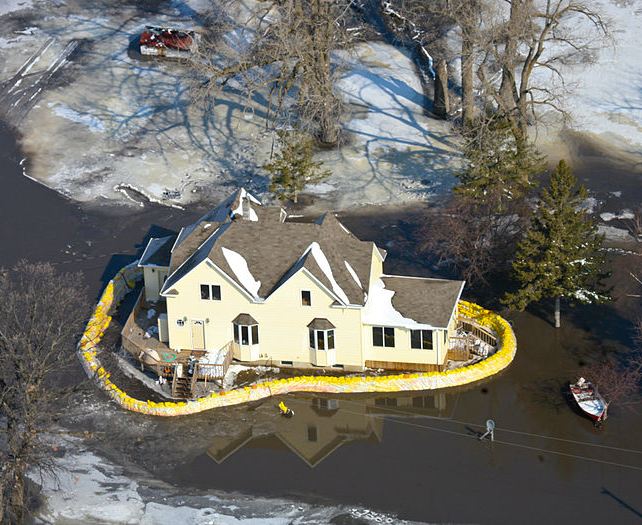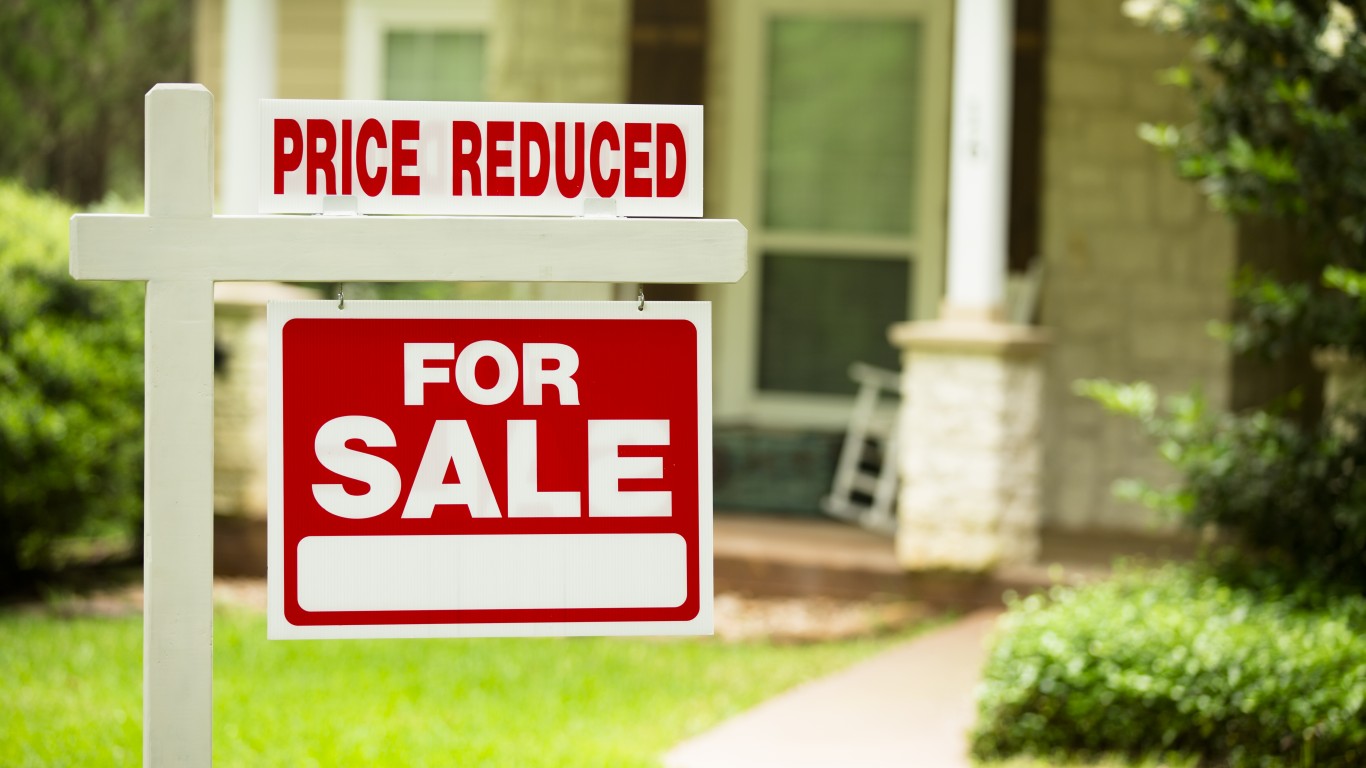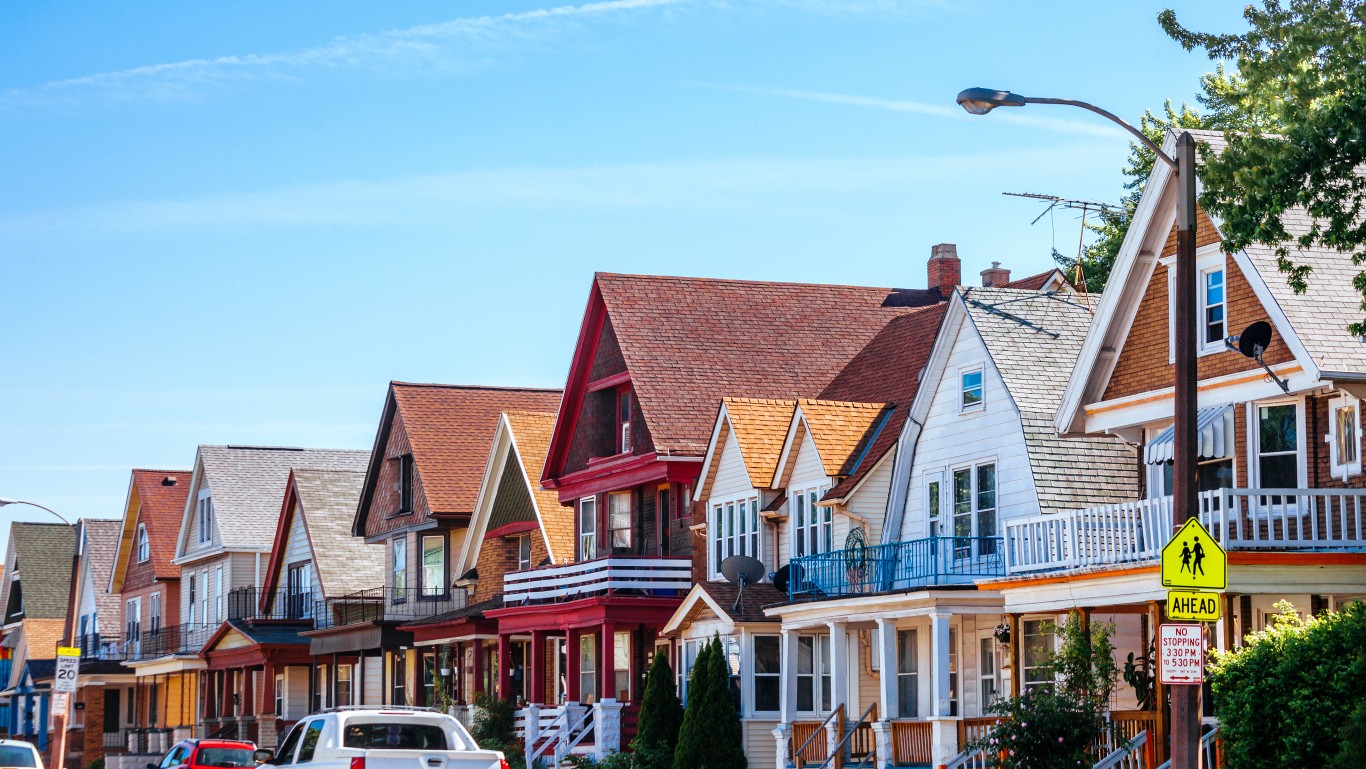As home prices continue to slide, more and more homeowners find themselves owing more on their homes than those houses are worth. The slowing level of foreclosure activity last year only exacerbated the problem, leaving more homes in trouble on the market. Last week, Corelogic reported that the number of underwater mortgages as a percentage of all mortgaged homes rose in the fourth quarter of 2011 to its highest level since 2009, the first year the property analytics provider began reporting the data.
Read: The Ten States Sunk By Underwater Mortgages
According to Corelogic’s Negative Equity report, the mortgages on more than 11.1 million homes, or 22.8% of the nation’s 48.7 million mortgaged homes, are underwater. Based on Corelogic’s report, 24/7 Wall St. identified the 10 states with the highest percentage of underwater mortgages.
Some of the states with a high percentage of underwater mortgage had economic problems long before the recent recession. States like Michigan and Rhode Island have experienced long-term industrial declines for some time. In these areas, drops in home values were only accelerated by the recession.
For most of the states on the list, however, a decline in home values is the main reason homeowners suddenly found themselves owing more on the their houses than they are worth. These states, which include Nevada and Arizona, experienced some of the biggest housing booms in the country. Many homeowners took out mortgages when home values were at their highest. The plunge in housing values was just as big, though. As a result, nearly half of all mortgages in these states are underwater.
Being underwater does not ensure financial disaster for homeowners — so long as they are otherwise financially secure. In states like Virginia, for example, high median income and low unemployment has contributed to a relatively low rate of homes that are 90 days or more late on their payments, or are in foreclosure. This is despite the fact that 23% of the state’s mortgages are underwater, the 10th-highest rate in the country.
Most of the states on the list, however, are not as fortunate as Virginia. Seven of the 10 worst-off states have unemployment rates above the national average. Six of them have median household incomes below the national average. According to Fiserv’s home price projections, nine of the 10 states on this list will continue to see home values fall substantially through the third quarter of this year.
24/7 Wall St. relied on Corelogic’s Q4 2011 Negative Equity report to determine the states with the highest percentage of mortgages with negative equity. Because of sample size, seven states were excluded from their results. These states, which include Wyoming and Vermont, account for fewer than 5% of the total U.S. population. In our own analysis, we examined a variety of metrics. We included December unemployment rates provided by the Bureau of Labor Statistics and median income, median home value and poverty rate from the U.S. Census Bureau. Declines in home value from peak to fourth quarter of 2011 is from FHFA. Fourth-quarter 2011 delinquency (90+ days) and foreclosure rates are from Corelogic. Forecast changes in home value by state are from Fiserv.
10. Virginia
> Pct. homes underwater: 23%
> Total property value: $428.46 billion
> Mortgage debt outstanding: $307.48 billion
> Median home value drop from peak: 16.7% (21st-biggest decline)
> Homes in foreclosure or 90+ days delinquent: 4.1% (ninth-smallest percentage)
According to CoreLogic’s Q4 2011 report, 23% of Virginia’s mortgaged homeowners owe more on their mortgages than their property is worth. An additional 6% are on the verge of being underwater. Compared to many of the markets that have large numbers of upside-down homeowners, Virginia was not one of the worst-hit markets by the housing collapse. Despite the high percentage of underwater mortgages, the rate of mortgaged homes in delinquency or foreclosure is one of the lowest in the country. One of the reasons for this is the ability of homeowners to remain solvent. Virginia has an unemployment rate of just 6.2%, the 11th lowest in the country, as well as low poverty and high median income.
Also Read: Op-Ed: How Higher Gas Prices Hurt Less Affluent Consumers and the Economy
9. Ohio
> Pct. homes underwater: 23.9%
> Total property value: $310.62 billion
> Mortgage debt outstanding: $238.20 billion
> Median home value drop from peak: 14.4% (23rd-biggest decline)
> Homes in foreclosure or 90+ days delinquent: 6.9% (14th-largest percentage)
Of the 2.2 million mortgages in the state of Ohio, more than 525 million have negative equity, and an additional 134 million are on the brink of being underwater. As of the end of 2011, 6.9% of homes in the state were either currently in foreclosure or have been delinquent for 90 days or more on payments. The total value of all mortgaged homes in the state is $310 billion, and outstanding mortgage debt for those homes is $238 billion. This loan-to-value ratio, 76.7%, is the sixth highest in the country.
8. Maryland
> Pct. homes underwater: 24.3%
> Total property value: $418.34 billion
> Mortgage debt outstanding: $296.81 billion
> Median home value drop from peak: 23.7% (12th-biggest decline)
> Homes in foreclosure or 90+ days delinquent: 8.0% (tied for fifth-largest percentage)
Like those in Virginia, Maryland’s residents appear to be in good financial shape, despite the fact that nearly one in four mortgaged homes are underwater. Median income in the state is the highest in the country and the poverty rate is the third lowest. However, this has not been enough to save a large percentage of state residents from financial troubles. Some 8% of mortgaged homes are either in foreclosure or at least 90 days delinquent on their mortgages, tied for the fifth-highest rate in the country.
7. Idaho
> Pct. homes underwater: 25.0%
> Total property value: $49.76 billion
> Mortgage debt outstanding: $36.58 billion
> Median home value drop from peak: 29.3% (sixth-biggest decline)
> Homes in foreclosure or 90+ days delinquent: 5.2% (20th-smallest percentage)
Like Maryland, nearly one in every four Idaho homes are underwater, although the financial situations of the two states could not be more different. Idaho has the 13th-lowest median income in the country, above-average unemployment and a poverty rate of 14.3% (compared to Maryland’s 9.1%). Since its peak in the first quarter of 2011, home prices in the state of Idaho have fallen nearly 30%. According to Gallup’s recent consumer confidence poll, Idaho residents had the third-lowest confidence in the national economy of any state.
Also Read: What Happens if Iran Closes the Strait of Hormuz
6. California
> Pct. homes underwater: 29.9%
> Total property value: $2.73 trillion
> Mortgage debt outstanding: $1.94 trillion
> Median home value drop from peak: 46.7% (third-biggest decline)
> Homes in foreclosure or 90+ days delinquent: 7.0% (12th-largest percentage)
As of the fourth quarter of 2011, there was $8.7 trillion in mortgage debt nationwide — $1.94 trillion of that, or 22%, is located in California. Nearly 30% of California’s mortgages are underwater, and 16.1% of mortgages are worth less than 80% of their debt. From its prerecession peak in the first quarter of 2006, home values have fallen 46.7% and are projected to fall an additional 4.2% by the third quarter of this year.
5. Georgia
> Pct. homes underwater: 33.0%
> Total property value: $306.59 billion
> Mortgage debt outstanding: $252.81 billion
> Median home value drop from peak: 26% (10th-biggest decline)
> Homes in foreclosure or 90+ days delinquent: 8.0% (tied for fifth-largest percentage)
One-third of mortgage owners in Georgia have more mortgage debt than their homes are worth. Since the home values peaked in the state in 2007, prices have declined 26%. The state has the ninth-most mortgaged homes in the country and even more homes underwater. At 540,000 it has the fourth-most underwater mortgages of any state. Georgia’s unemployment rate is the ninth-highest in the country.
Also Read: China’s 7.5% Growth and the Rest of the World
4. Michigan
> Pct. homes underwater: 34.7%
> Total property value: $198.05 billion
> Mortgage debt outstanding: $165.45 billion
> Median home value drop from peak: 30.1% (fifth-biggest decline)
> Homes in foreclosure or 90+ days delinquent: 6.5% (19th-largest percentage)
Michigan’s economy and housing market was already in bad shape leading up to the recession, and things have only gotten worse. The state experienced a net loss in population between 2000 and 2010, the only state that lost residents during the period. Unemployment has improved somewhat in the past few years, but it is still the tenth-highest rate in the U.S. Michigan home value began to decline before the recession hit, after peaking in 2005. Since that time, home prices have dropped by 33%.
3. Florida
> Pct. homes underwater: 44.2%
> Total property value: $809.95 billion
> Mortgage debt outstanding: $706.00 billion
> Median home value drop from peak: 44.8% (fourth-biggest decline)
> Homes in foreclosure or 90+ days delinquent: 17.4% (the largest percentage)
No state has a larger gross vacancy rate than Florida, standing at more than 20%. When the housing market flourished, the state geared up for the impending retirement of millions of baby boomers by constructing tens of thousands of new homes. When the market collapsed, real estate investments in the state were hit hard. Florida’s home value has plummeted by more than 40% — the second largest drop in the country — and nearly one in two mortgaged homes are underwater.
2. Arizona
> Pct. homes underwater: 48.3%
> Total property value: $243.02 billion
> Mortgage debt outstanding: $226.22 billion
> Median home value drop from peak: 47.9% (second-biggest decline)
> Homes in foreclosure or 90+ days delinquent: 7.1% (11th-largest percentage)
Through the first half of the decade, states like Nevada, Utah and Arizona experienced record growth in population, business and, as a result, new construction. Conditions reversed in 2008, and the states that once led in property value growth and employment, like Arizona, fell through the floor. In the third quarter of 2006, Arizona had median home value of $254,655. To date, that value has dropped by more than $100,000. Some 48.3% of all mortgaged homes are now underwater.
1. Nevada
> Pct. homes underwater: 61.1%
> Total property value: $96.57 billion
> Mortgage debt outstanding: $109.94 billion
> Median home value drop from peak: 60% (the biggest decline)
> Homes in foreclosure or 90+ days delinquent: 13.4% (second-largest percentage)
Like Arizona, Nevada’s property value has plummeted since the middle of the decade, losing more than $150,000 on average (more than 50%) in just five years. Nevada is also the only state in the country in which total homeowner debt is actually higher than the total property value of owned homes — nearly two in three mortgaged homes are underwater. As of the end of 2011, 13.4% of mortgages were either already in the foreclosure process or more than 90 days delinquent on their payments.
-Michael B. Sauter
The Average American Is Losing Momentum On Their Savings Every Day (Sponsor)
If you’re like many Americans and keep your money ‘safe’ in a checking or savings account, think again. The average yield on a savings account is a paltry .4%1 today. Checking accounts are even worse.
But there is good news. To win qualified customers, some accounts are paying more than 7x the national average. That’s an incredible way to keep your money safe and earn more at the same time. Our top pick for high yield savings accounts includes other benefits as well. You can earn up to 4.00% with a Checking & Savings Account today Sign up and get up to $300 with direct deposit. No account fees. FDIC Insured.
Click here to see how much more you could be earning on your savings today. It takes just a few minutes to open an account to make your money work for you.
Our top pick for high yield savings accounts includes other benefits as well. You can earn up to 4.00% with a Checking & Savings Account from Sofi. Sign up and get up to $300 with direct deposit. No account fees. FDIC Insured.
Thank you for reading! Have some feedback for us?
Contact the 24/7 Wall St. editorial team.


